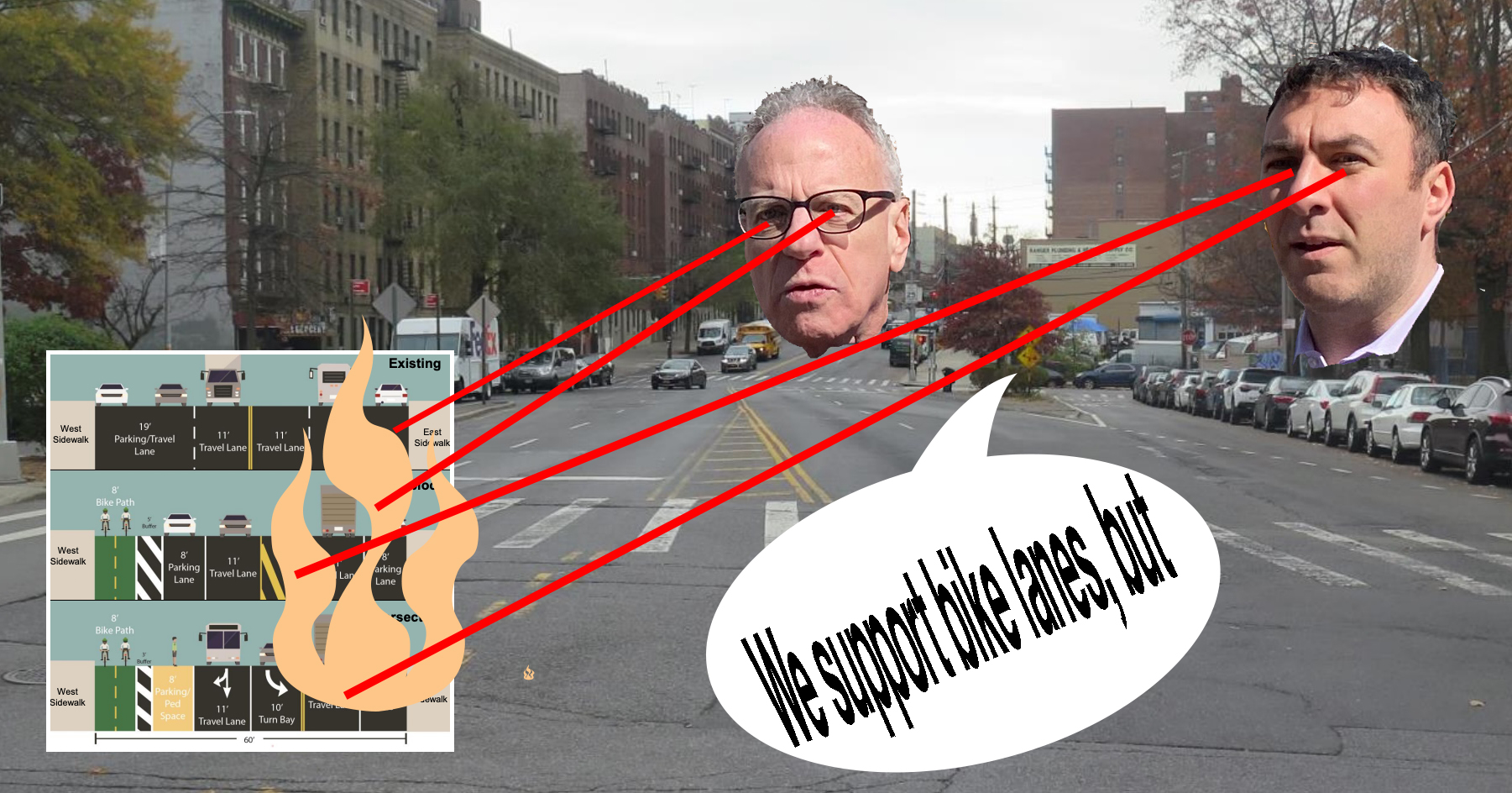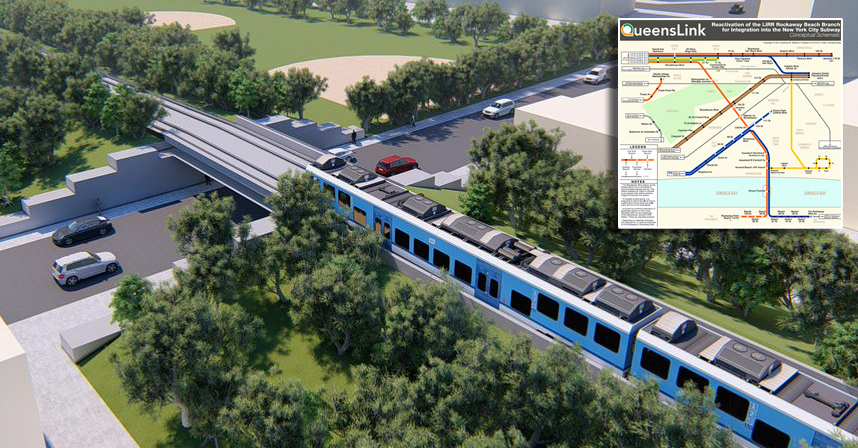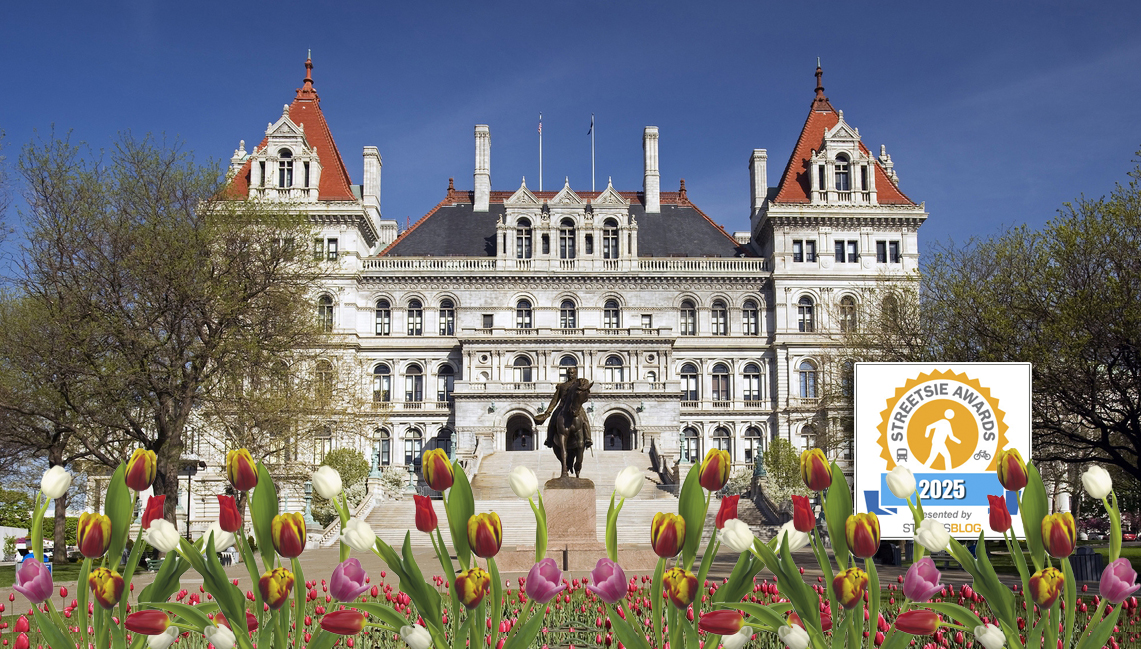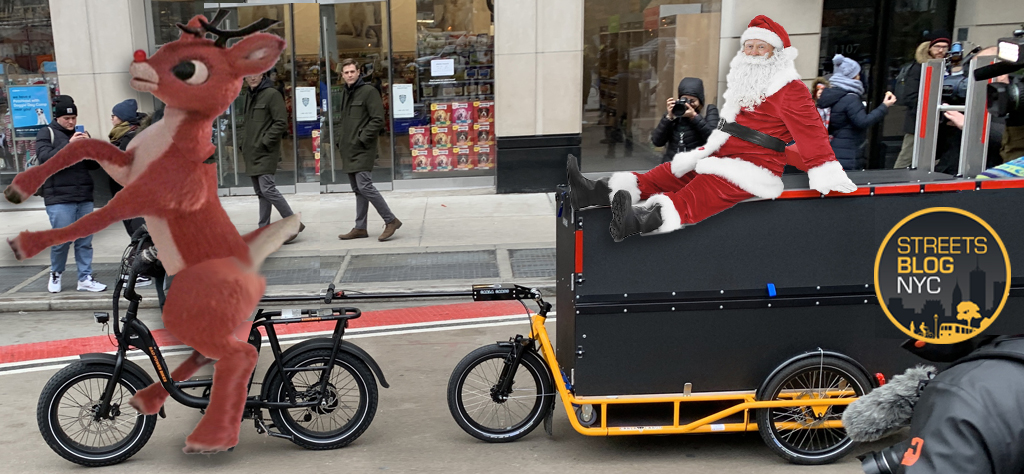A father-son pair of Bronx politicians are throwing a tantrum over, in their words, the city's latest "anti-car crusade" — a basic two-way on-street protected bike lane that repurposes all of 46 parking spots to create the first segment of the mayor's Harlem River Greenway.
"DOT's approach is not about safety – it's about an anti-car crusade that disregards input from our residents and businesses alike. At this rate, there won't be any parking spots left," Assembly Member Jeffrey Dinowitz and his son, Council Member Eric Dinowitz, said in a statement posted on Facebook on Tuesday that confusingly began with, "We support bike lanes."
"The Bailey Avenue redesign is being imposed over clear and repeated objections from the community," Dinowitz and Dinowitz said.
Bailey Avenue south of Van Cortlandt Park to W. 225th Street is one of the first major sections of the Harlem River Greenway announced by Mayor Adams in March 2023. Altogether, the Department of Transportation wants to install what will become a seven-mile bike path all the way down to Randall's Island, going through areas with little or no protected cycling infrastructure.
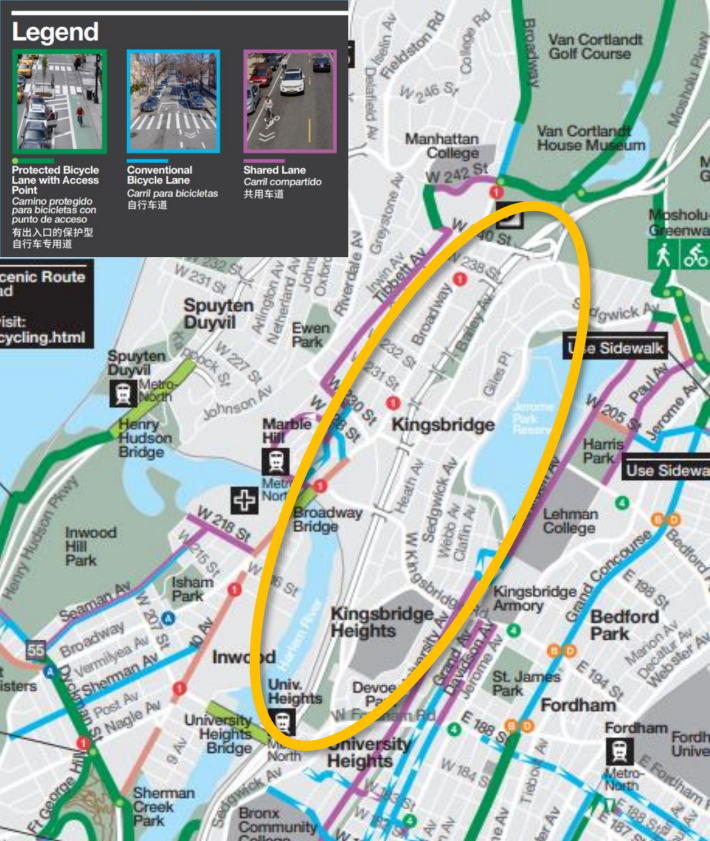
Oppositions centers on the 1.1-mile Bailey Avenue project's northern end, where traffic crashes have injured hundreds of people have been in recent years.
DOT's redesign changes the 60-foot-wide road from two travel lanes in each direction to one [PDF].
Rhetoric versus reality
Despite the lawmakers's rhetoric, the agency will only swap out about four parking spots per block — or roughly 46 along the entire corridor — and mostly from corners to add pedestrian islands and improve visibility.
A whopping 179 people have been injured in crashes on the strip between 2020-2024 including 18 people severely, and another two people have been killed. The most common pedestrian injuries were caused by drivers failing to yield to pedestrians who crossed with the light, according to DOT — heightening the importance of the parking changes at the intersections.
Protected bike lanes are proven to reduce the number of pedestrians killed or seriously injured by 29 percent, and 39 percent among seniors, according to DOT. Removing car travel lanes, also known as a road diet, also lowers those numbers by 30 percent, the agency has found.

The agency will also remove parking near corners, a street safety design known as daylighting, which makes it easier for drivers and pedestrians to see each other. Nearly eight in 10 pedestrian traffic injuries happen at intersections, according to DOT.
Some parking must give way in order to add turn bays at corners, to better organize the chaotic road, officials recently told locals at a community board meeting.
"For drivers, there’s excess capacity. These two travel lanes result in speeding, double parking, swerving and unpredictable behavior," DOT official Nathan Albert told Community Board 8's Traffic and Transportation Committee on April 17. "Because of the double parking all along the corridor, we see cyclists swerving into the left lane of traffic sometimes to get around them. This is just an unacceptable and unsafe situation."
Mixed views
The reactions at the CB 8 meeting were mixed, with one local saying the removal of 46 spaces was "devastating," but another Bronxite who lost his brother in a traffic crash made clear that the stakes are about more than driver convenience.
"There’s tradeoffs here, but the tradeoffs are lives," said Thomas Proctor.
Assembly Member Dinowitz contended that he had "no issue" with the bike lane, but that DOT should make a greater effort to keep car storage, a phrase for parking the lawmaker took exception to. He suggested the agency should instead look into installing more stop signs and speed humps, and accused Streetsblog for being "totally insensitive" for referring to parking as "car storage."
"We did raise serious concerns about the removal of a large number of parking spots in an area that’s already starved for parking. Your loaded term, 'car storage,' is totally insensitive to the needs and wishes of the neighborhood. We can have bike lanes and at the same time not have to remove so many parking spots," Dinowitz told Streetsblog in an email.
The younger Dinowitz did not respond for comment by press time, but after publication, the Council member posted an edited version of this story's leading image, accusing Streetsblog of not being a journalistic outlet, adding "I too can use Microsoft Paint."
I too can use Microsoft Paint. https://t.co/kSHKMtqJWj pic.twitter.com/aXNk42vhrp
— Eric Dinowitz (@EricDinowitz) July 8, 2025
The two pols have previously called for signs and humps after a hit-and-run driver hit a 9-year-old girl in Riverdale, but also balked at more serious street safety redesigns that would have removed some space for cars.
Longtime local greenway advocates urged the Adams administration to forge ahead with the plan and not get bogged down in localized resistance, especially given that the paths would connect as far as the Empire State Trail.
"It’s not just an issue for Community Board 8 but it’s an issue for the entire bronx, New York City and the region," said Chauncy Young, who coordinates the Harlem River Coalition and is a co-chair of the New York City Greenway Coalition. "These daylighted intersections will make it safer for cars and pedestrians and giving a road diet to Bailey Avenue will hopefully control the speed and not allow it to be used as an off ramp to the Deegan Expressway."
Hizzoner originally billed the larger project as a "waterfront greenway," but because some of the land along water is outside of the city's remit, the Department of Transportation revealed in March that it would shift to on-street bike paths for the near term.
A DOT spokesperson defended the project, adding the agency will "evaluate" adding parking back again at nearby "No Standing" and "No Parking" spots.
"Bronx residents deserve safer access to their waterfronts — and even drivers will appreciate cyclists having their own lane, instead of sharing a travel lane or riding on sidewalks," said Vin Barone in a statement. "This design has been installed along countless streets across the city and will enhance safety for everyone on of the Bronx’s most dangerous streets — while also creating a better driving experience with new turning lanes."
DOT plans to complete the redesign this year.
Update (July 8, at 3:37 p.m.): This story has been updated with a social media post by Eric Dinowitz mocking Streetsblog.
